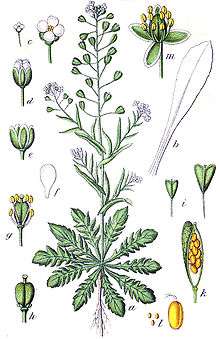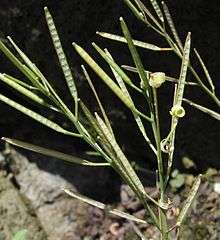Silique
A silique or siliqua (plural siliques or siliquae) is a type of fruit (seed capsule) having two fused carpels with the length being more than three times the width.[1] When the length is less than three times the width of the dried fruit it is referred to as a silicle.[2] The outer walls of the ovary (the valves) usually separate when ripe, then being named dehiscent, and leaving a persistent partition (the replum). Siliques are present in many members of the mustard family, Brassicaceae, but some species have silicles instead. Some species closely related to plants with true siliques have fruits with a similar structure that do not open when ripe; these are usually called indehiscent siliques (compare dehiscence).
 Silicles of Lunaria annua – MHNT
Silicles of Lunaria annua – MHNT Capsella bursa-pastoris with silicles
Capsella bursa-pastoris with silicles Indehiscent siliques of radish Raphanus sativus
Indehiscent siliques of radish Raphanus sativus

Siliquae of Cardamine impatiens
See also
- Legume – a fruit type that somewhat resembles a silique, but is derived from one carpel that typically splits along two sides.
References
- Hickey, M.; King, C. (2001). The Cambridge Illustrated Glossary of Botanical Terms. Cambridge University Press.
- Kristin Huisinga; Lori Makarick; Kate Watters (2006). River and Desert Plants of the Grand Canyon. Mountain Press Publishing Company. pp. 241–. ISBN 978-0-87842-523-5.
| Wikimedia Commons has media related to Silique. |
This article is issued from Wikipedia. The text is licensed under Creative Commons - Attribution - Sharealike. Additional terms may apply for the media files.